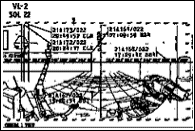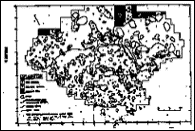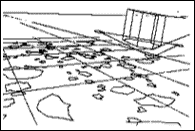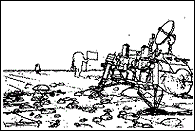How It's Done
When asked by NASA's Exploration Programs Office to produce a scene of the first human visit to a Viking Lander on Mars, Rawlings decided to make the scene as realistic as possible. Choosing the Viking 2 lander site's higher latitude allowed Rawlings to show early morning frost on the rocks and the lander, thereby demonstrating the prescence of an atmosphere and water.
 |
Step 01By matching Viking panoramic images of the site with transparent overlays made from gridded line drawings Rawlings was able to lay the grid over the rocky surroundings. |
 |
Step 02Rawlings then scanned a rock map created by Viking scientists into a 3-D modeling program where he added a grid that matched the "overlay" grids. |
 |
Step 03Now the Lander had to be incorporated into the landscape. Viking 2 images with tilted horizons showed that the one of the lander's legs had come down on a rock causing an 8 degree tilt. A properly tilted "stick figure" lander was modeled and locked onto the computer landscape scene was then rotated until the"stick" lander's perspective matched a reference lander mockup photo. |
 |
Step 04From this base, numerous photos and engineering references Rawlings created a full-size drawing and transferred it to the painting surface using graphite paper.Working with the gridded color images and other detailed Viking surface images as reference, Rawlings applied acrylic paint using airbrushes, paint brushes, sponges paper towels and his fingers. The colors, based on Viking lander images and tones, are adjusted for the time of day. |
During the painting process, Dr. Alan Binder of the Viking Imaging Team reviewed the position and scientific accuracy of the landscape. Dust and frost are added to reflect the lander's age and the early morning setting. The flag, carried by the closest person, is silhouetted in order to raise the question, "What country will land on Mars first?"





